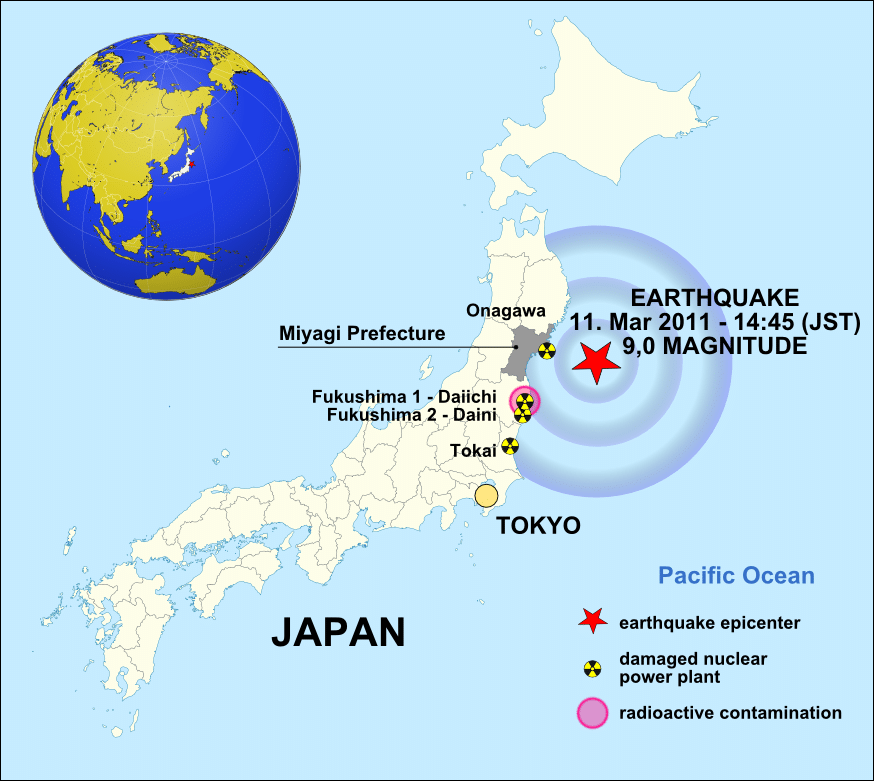A Fukushima lesson: Victim compensation schemes need updating
By Hirokazu Miyazaki | March 10, 2021
 Map of Japan showing the March 11, 2011 earthquake. Credit: W. Rebel via Wikimedia Commons. CC BY-SA 3.0.
Map of Japan showing the March 11, 2011 earthquake. Credit: W. Rebel via Wikimedia Commons. CC BY-SA 3.0.
At the 10th anniversary of the devastating earthquake and tsunami that set off a meltdown at Tokyo Electric Power Company’s Fukushima Daiichi nuclear power plant, it is time to revisit the laws that govern compensation for victims of such disasters.
Fortunately, major nuclear accidents are rare. To date, only Fukushima and the 1986 Chernobyl disaster in Russia are rated level 7 “major” accidents by the International Atomic Energy Agency. But given the potential for nuclear power generation to expand, accidents of various levels of severity could also increase in frequency.
Today, nuclear energy is used to produce about 10 percent of electricity worldwide. However, the desire to limit the environmental impact of carbon-based energy sources is putting nuclear power generation in the spotlight. For example, the International Energy Agency’s World Energy Outlook 2020 includes a “sustainable development scenario,” under which electricity generated from nuclear power could increase by almost 55 percent in 2040. Given this outlook, expanding protection for victims, including the amount and scope of compensation they can receive, should become an international priority for the industry, policymakers, and global nuclear organizations.
As my colleagues and I who are part of the Meridian 180 Global Working Group on Nuclear Energy have found, domestic laws and international conventions around nuclear power and compensation for victims of accidents are insufficient and need to be revisited. These laws and protocols were designed, at least originally, to promote nuclear energy and protect the interests of the nuclear power industry. Given the infrequency of major accidents, the laws and protocols have not been tested very often.
The laws limit the liability faced by nuclear power plant operators and manufacturers and the amount of compensation paid to victims. As a result, investors can pursue nuclear energy projects without fear of a potentially significant burden to compensate victims if a major accident were to occur. But the potential for accidents remains. Rather than assume they can be prevented, we must prepare for them—not only with emergency plans and safety protocols, but also with laws that protect and compensate the victims.
Compensation claims remain unresolved. The Chernobyl disaster did lead to some reform of international and domestic laws to strengthen victim protections. But since Fukushima, few regulatory policy changes have been enacted, inside or outside Japan, and Fukushima damage compensation claims remain unresolved. Among the victims in Fukushima Prefecture are thousands of local residents who faced losses — of their homes, communities, ancestral homelands, and day-to-day life activities. Although not directly attributable, the deaths of more than 1,500 people have been linked to physical and mental stresses related to the evacuation after the nuclear reactor meltdowns.
Tokyo Electric Power Company has paid more than 9.7 trillion yen (or approximately $92 billion) to nuclear accident victims, the largest damage payout ever made to such victims and among the highest (if not the highest) paid in any industrial disaster. But dissatisfaction and unsettled claims remain. Some have not been compensated for losses because their residences were outside mandatory evacuation zones. Nearly 30 collective lawsuits brought against Tokyo Electric Power Company and the Japanese government are pending.
Three goals for deliberative conversation. Fair treatment and compensation for victims and those impacted by nuclear accidents can best be achieved through a deliberative conversation that is anticipatory, participatory, and transnational:
- Anticipatory. Discussion of laws that govern nuclear power and provide for compensation of victims must occur before the next disaster. Many dedicated professionals continue working to prevent future nuclear accidents. Based on the case studies that Meridian 180 members have assembled and presented, however, most governments are not fully prepared for nuclear disaster. Specifically, plans do not anticipate the magnitude and types of harm people experience after disasters, nor do they specify how people will be compensated for losses. In addition, some plans have loopholes for nuclear accidents that are caused by natural disasters, which could lead nuclear plant operators to inadequately prepare for environmental hazards. Moreover, assumptions that the probability of a nuclear disaster is very low results in a kind of complacency. Citizens often accept nuclear power plants because they feel assured a disaster is extremely unlikely. When a nuclear accident does occur, the tendency in the nuclear industry is to explain it as an anomaly — operator error, poor governance, substandard engineering — all of which serve to give the false hope that addressing such problems can prevent disasters and lead to inadequate compensation plans for accident victims. For example, Japan’s Nuclear Damage Compensation Act stipulates that the operator of a nuclear power plant should assume sole responsibility for nuclear accident compensation. Yet the amount of damage compensation required in the wake of the Fukushima reactor meltdowns far exceeded the Tokyo Electric Power Company’s ability to pay—and raised the question of who should Shouldn’t the Japanese government, which had promoted nuclear power as a safe and cheap source of energy, also be responsible? Some Fukushima accident compensation costs have been passed on to ratepayers who benefit from nuclear energy, but the scope of responsibility is a question that requires careful and inclusive deliberation, before the next nuclear accident occurs.
- Participatory. Any forum on nuclear disaster compensation must include a wide variety of people and interests, including ordinary citizens who have been impacted, or are likely to be impacted, by a disaster as well as nuclear engineers, medical doctors, environmental scientists, and other experts with specialized knowledge. People must be allowed to participate and contribute equally — particularly citizens who are economically disadvantaged and do not have a choice when it comes to accepting the risks of living and working in proximity to a nuclear power plant or nuclear waste disposal site. In the past, ordinary citizens have not been given the same opportunities as experts from governments and corporations to provide their opinions and share experiences. In addition, such forums should cast a wide geographical net, recognizing that disasters can have widespread fallout that affects the environment and agricultural production far beyond the region in which they occur.
- Transnational. Nuclear disasters do not respect national borders, so forums on accident compensation must be transnational—a departure from past practice. Models of transnational forums do exist; meetings on climate change bring together officials from multiple national governments, regional and municipal governments, and nongovernmental organizations. A transnational conversation on nuclear power should include decision-makers and citizens from nations that are considering investing in nuclear power, with frank discussions about the risks of nuclear disasters. Such exchanges should also highlight the implications of compensating citizens who live beyond the borders of the state or region where a catastrophe occurs.
Preparing for the next one. The nuclear disaster at Fukushima was deeply transnational in scope and participation: The US-designed reactors at the Fukushima plant used nuclear fuel that was mined outside Japan, likely in Canada, Kazakhstan, Niger, Australia, Russia, or Namibia, six countries that supply more than 85 percent of the nuclear fuel used worldwide.
As nuclear power plants continue to operate, and with the prospect that more plants will be built in the future, the potential for accidents remains. Rather than assume they can be prevented, we must prepare for them — not only with emergency plans and safety protocols, but also with laws that protect and compensate the victims, which can only stem from discussions at all levels of government and industry that meaningfully include those most likely to be injured, should another nuclear disaster occur.
Together, we make the world safer.
The Bulletin elevates expert voices above the noise. But as an independent nonprofit organization, our operations depend on the support of readers like you. Help us continue to deliver quality journalism that holds leaders accountable. Your support of our work at any level is important. In return, we promise our coverage will be understandable, influential, vigilant, solution-oriented, and fair-minded. Together we can make a difference.
Keywords: Fukushima, compensation, evacuation, nuclear accident liability, nuclear accident victims, nuclear accidents
Topics: Nuclear Energy, Nuclear Risk















